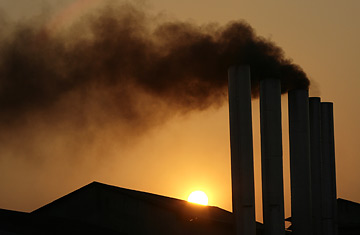
Smoke rises out of factories near Bangkok, Thailand.
When the world begins a new round of negotiations on climate change next month in Bali, Indonesia, each of us will have a seat at the table. We are all emitters of carbon dioxide — the main cause of man-made climate change — each time we drive or use electricity. But even more importantly, we are all citizens. The U.S. Government, together with the other 190 governments at the negotiations, will have to set new rules of the game for producing and using energy. Our power as citizens is to ensure that they do.
The old rules of the game will bring us to ruin. Fossil fuels — coal, oil, and natural gas — have powered economic development for two centuries, and without them we'd all be stuck in poverty. But we've learned step by step of harmful side effects. First we learned that coal-fired power plants created acid rain, so we changed the rules of the game to insist on smokestack scrubbers to eliminate pollutants like sulfur oxides. Second we learned that automobiles produced pollutants that caused smog, so we changed the rules to insist on catalytic converters. Now we've learned that the carbon dioxide produced by burning fossil fuels is causing dangerous climate change. We'll need to change the rules of the game one more time.
There is a difference, however, between the problems of carbon dioxide emissions and those of acid rain or smog. The carbon dioxide emitted by power plants, automobiles, steel mills and home furnaces doesn't just affect our local environment or the lakes and forests a few hundred miles downwind; it accumulates in the atmosphere and affects the entire planet. U.S. emissions are changing the climate in Africa and Asia, just as the soaring emissions of China are affecting America's climate. The results are already deadly, causing failed crops in Africa, killer heat waves in Europe, extreme droughts in the U.S. southwest, and more. And much worse is to come unless we act.
We therefore need a global agreement on new rules of the game to take carbon emissions out of our energy system. Part of the answer will be akin to the smokestack scrubbers. Engineers have shown that it is possible to capture the carbon dioxide before it is emitted from a coal-fired power plant, and to transport it to long-term underground storage, in a process known as "carbon capture and sequestration." They've also dramatically reduced the costs of non-fossil-fuel electricity from wind, solar power and geothermal power, with further savings achievable based on experience and more research and development. France and other countries have also demonstrated that nuclear power plants can be safe, efficient and low cost if properly regulated.
The arithmetic of carbon dioxide tells us pretty clearly about the kind of global agreement that we will need. The world economy is growing at about 5% per year, a rate that causes the size to double every 14 years. Energy demand will rise at a similar rate minus the energy saving we can achieve through improved efficiency. World energy demand might triple by 2050, yet we'll have to bring emissions at mid-century well under today's global rate if the world is to stay safe. The point is that all major economies, including the U.S., Europe, Japan, China, and India, will need to shift, and shift soon, to low-emission power plants, automobiles and factories.
Here's what might happen. The major economies will have to shift decisively to low-emission electricity plants, partly through increased use of renewable and nuclear energy, and partly through carbon capture and sequestration. Automobile emissions will be slashed through new designs, such as the "plug-in hybrid" technology, in which cars will be powered by a mix of gasoline and electricity and will be plugged into the wall socket for an overnight charge. Large industrial emitters like cement, steel and petrochemical factories will also have to capture their own carbon dioxide emissions as well. And our buildings will be greener too, with better insulation, and heating through solar power and low-emission electricity rather than home furnaces.
This changeover won't be free, but it won't break the bank, especially if we start early, proceed globally and undertake research and development on low-emission energy systems to improve our options. The best guess is that the annual cost of the changeover will remain below 1% of the world's annual income, a very modest price to avoid a potential earthshaking danger. The rich countries will have to help the poor countries in three ways: to get access to the needed low-emission technologies; to bear part of the increased costs of energy in the poor countries at least until those countries can afford it on their own; and to take steps to adjust to the climate change that is already underway and that will still get worse even if we make all of the urgent and needed changes in the energy rules of the game.
So here are some guidelines to use our citizens' power. Let's demand action from our government and other governments to settle on new rules of the energy game, and demand the same from our Presidential candidates as well. Let's be clear that we are ready to pay a bit more for electricity, perhaps another 2 to 3 cents per kilowatt hour, if it means a big cut in carbon dioxide emissions. Let's also get ready for plug-in hybrids, low-watt light bulbs, green buildings and other energy-saving and emissions-cutting technologies.
Climate change is truly a worldwide threat, yet it will only wreck the planet if we remain paralyzed with unreasoning fear and inaction. Like so many other problems that we've solved, this one too can be overcome through a combination of foresight, knowledge and ingenuity. And this time — if we're really smart about it — we'll have the whole planet working together in common cause.
